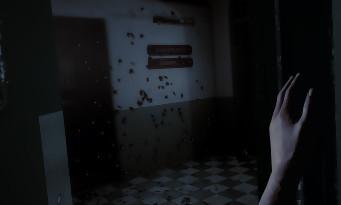 The story of The Inpatient takes place some sixty years before the events of Until Dawn, in the sinister asylum of Blackwood. The opportunity to experience from the inside the terrible tragedy that struck a team of miners stuck in the mountains. In the shoes of a man (or a woman) with amnesia, we will first have to respond to an interrogation led by Doctor Bragg, the owner of the premises whose experiences do not seem very clear. We quickly realize that in The Inpatient, one of the main objectives will be to gather enough memories to understand the meaning of our presence in Blackwood. An optional task that encourages exploration, although one should not expect a play area as spacious as that of Until Dawn. Moreover, the first hour essentially boils down to going around in circles and chatting in his cell, a few hallucinations breaking the ambient monotony. That said, these conversations do get you started with the voice features of PlayStation VR, as it's possible to speak responses aloud instead of selecting them with PlayStation Moves or the DualShock 4. That's pretty good seen in terms of immersion, especially since the recognition is at the top, and the lines are formulated in such a way that the result is as natural as possible.
The story of The Inpatient takes place some sixty years before the events of Until Dawn, in the sinister asylum of Blackwood. The opportunity to experience from the inside the terrible tragedy that struck a team of miners stuck in the mountains. In the shoes of a man (or a woman) with amnesia, we will first have to respond to an interrogation led by Doctor Bragg, the owner of the premises whose experiences do not seem very clear. We quickly realize that in The Inpatient, one of the main objectives will be to gather enough memories to understand the meaning of our presence in Blackwood. An optional task that encourages exploration, although one should not expect a play area as spacious as that of Until Dawn. Moreover, the first hour essentially boils down to going around in circles and chatting in his cell, a few hallucinations breaking the ambient monotony. That said, these conversations do get you started with the voice features of PlayStation VR, as it's possible to speak responses aloud instead of selecting them with PlayStation Moves or the DualShock 4. That's pretty good seen in terms of immersion, especially since the recognition is at the top, and the lines are formulated in such a way that the result is as natural as possible.
THE MORE THE CRAZY, THE MORE FLIPPER!
 On the other hand, we cannot be as complimentary with regard to the gestures that The Inpatient struggles to reproduce on the screen. Obviously, it is preferable to opt for the PS Move, but even with them, it is not easy to grab objects with precision. During our first run, we were convinced that it was not possible to nibble on the sandwich handed out by the nurse; however, we spent long minutes trying to bring it to our mouths. Moreover, if body awareness is an excellent thing, we sometimes have the impression that our character's head is slightly offset from the rest of his body, especially when we look down. But the pompom is still the management of collisions when picking up: the wrist tends to spin as soon as you are too close to a wall, for example. In short, fortunately the interactions are limited. Like Until Dawn, the game incorporates the famous butterfly effect with which each decision made has an impact on the rest of the adventure; and to be honest, the system is less efficient than with the group of teenagers. Indeed – without wishing to spoil anything – at no time do we have the feeling that such and such a choice can lead to the irremediable or to an immense relief; whereas in Until Dawn, we knew that we were bound to pay for overconfidence or a lack of empathy.
On the other hand, we cannot be as complimentary with regard to the gestures that The Inpatient struggles to reproduce on the screen. Obviously, it is preferable to opt for the PS Move, but even with them, it is not easy to grab objects with precision. During our first run, we were convinced that it was not possible to nibble on the sandwich handed out by the nurse; however, we spent long minutes trying to bring it to our mouths. Moreover, if body awareness is an excellent thing, we sometimes have the impression that our character's head is slightly offset from the rest of his body, especially when we look down. But the pompom is still the management of collisions when picking up: the wrist tends to spin as soon as you are too close to a wall, for example. In short, fortunately the interactions are limited. Like Until Dawn, the game incorporates the famous butterfly effect with which each decision made has an impact on the rest of the adventure; and to be honest, the system is less efficient than with the group of teenagers. Indeed – without wishing to spoil anything – at no time do we have the feeling that such and such a choice can lead to the irremediable or to an immense relief; whereas in Until Dawn, we knew that we were bound to pay for overconfidence or a lack of empathy.
Like Until Dawn, the game incorporates the famous butterfly effect with which each decision made has an impact on the rest of the adventure; and to be honest, the system is less efficient than with the group of teenagers.
 Afterwards, the narrative branches remain multiple and certain actions clearly modify the end of the game – without forcing, we discovered four of them, knowing that the protagonists can die along the way – but most of the consequences are anecdotal. One of the other criticisms that can be made of The Inpatient is its uneven rhythm. If Supermassive Games takes the time to set the scene at the beginning, everything accelerates suddenly – and in an incomprehensible way – thereafter. In addition, as our character is not able to run, even the supposed moments of tension leave us unmoved. It's a shame, because visually and audibly, the game largely does the job. The asylum is full of very filthy places, and the corpses that litter the ground contribute to the unhealthy atmosphere of The Inpatient. Despite the subjective view, we can't really say that the freak is there, only one jump scare having worked for us. In fact, the game activates known tricks, even if it means becoming predictable and flat. Finally, we regret that The Inpatient reveals absolutely nothing about the curse of the Wendigo, which would have made it possible to counterbalance with the particularly short lifespan and the insignificant secondary characters.
Afterwards, the narrative branches remain multiple and certain actions clearly modify the end of the game – without forcing, we discovered four of them, knowing that the protagonists can die along the way – but most of the consequences are anecdotal. One of the other criticisms that can be made of The Inpatient is its uneven rhythm. If Supermassive Games takes the time to set the scene at the beginning, everything accelerates suddenly – and in an incomprehensible way – thereafter. In addition, as our character is not able to run, even the supposed moments of tension leave us unmoved. It's a shame, because visually and audibly, the game largely does the job. The asylum is full of very filthy places, and the corpses that litter the ground contribute to the unhealthy atmosphere of The Inpatient. Despite the subjective view, we can't really say that the freak is there, only one jump scare having worked for us. In fact, the game activates known tricks, even if it means becoming predictable and flat. Finally, we regret that The Inpatient reveals absolutely nothing about the curse of the Wendigo, which would have made it possible to counterbalance with the particularly short lifespan and the insignificant secondary characters.


























